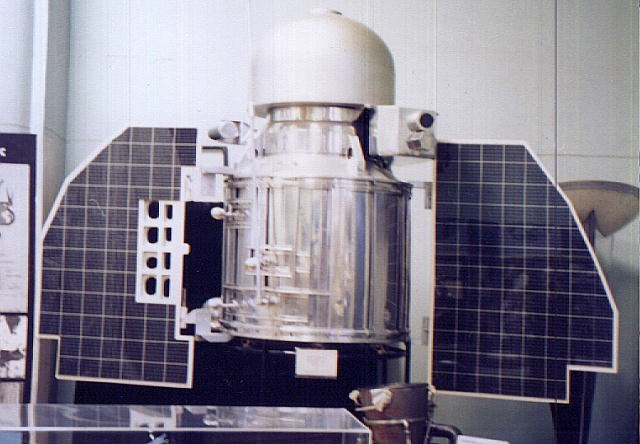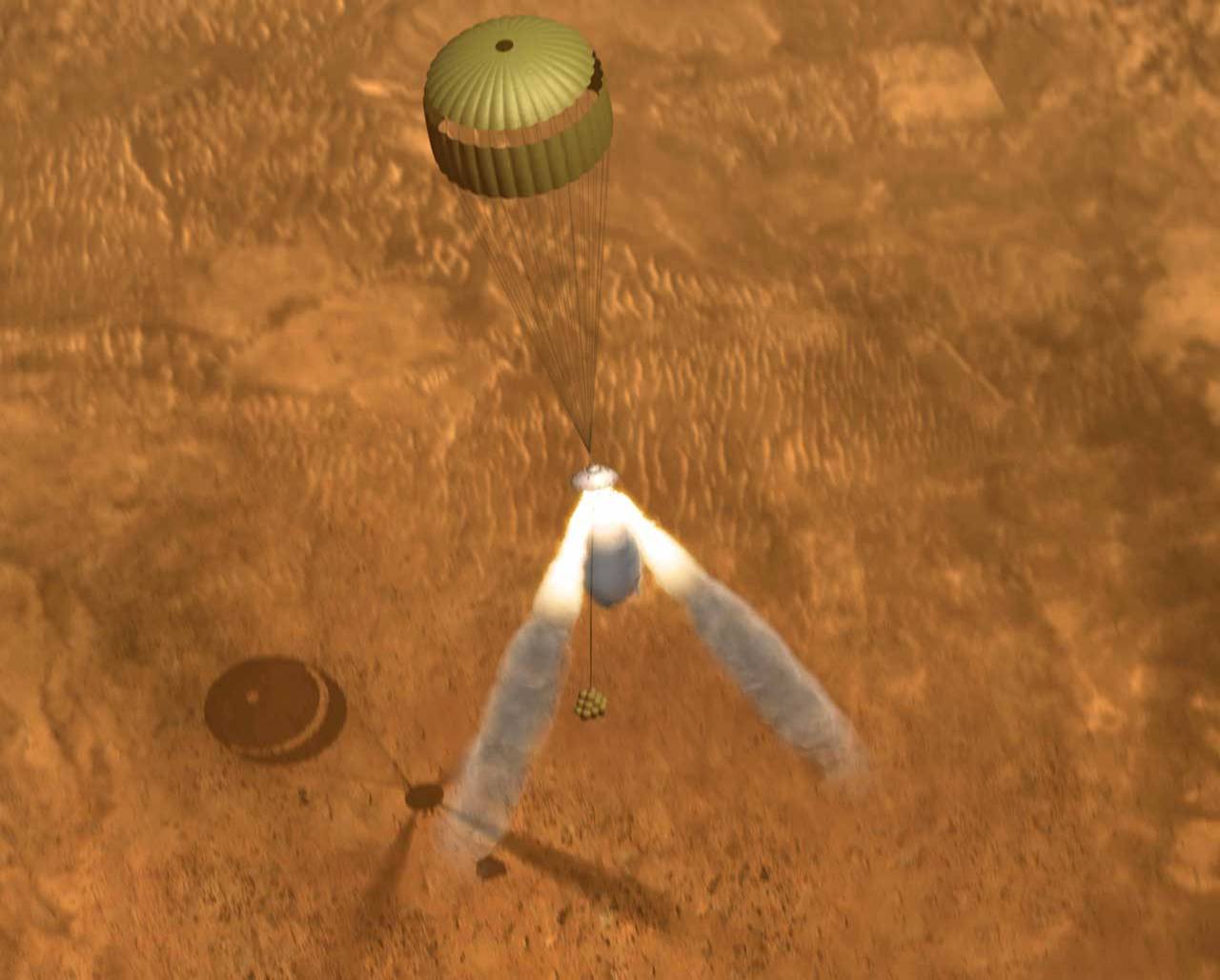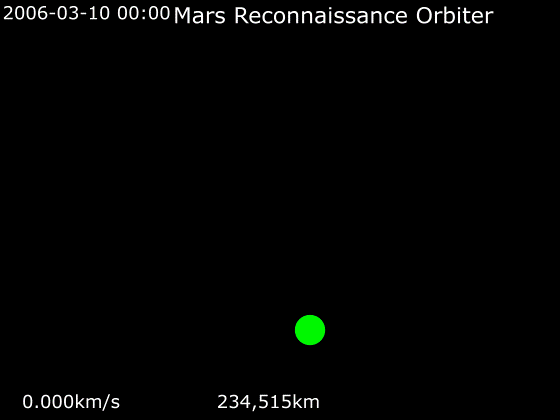|
Mars Probe Program
The Mars program was a series of uncrewed spacecraft launched by the Soviet Union between 1960 and 1973. The spacecraft were intended to explore Mars, and included flyby probes, landers and orbiters. Early Mars spacecraft were small, and launched by Molniya rockets. Starting with two failures in 1969, the heavier Proton-K rocket was used to launch larger 5 tonne spacecraft, consisting of an orbiter and a lander to Mars. The orbiter bus design was likely somewhat rushed into service and immature, considering that it performed very unreliably in the Venera variant after 1975. This reliability problem was common to much Soviet space hardware from the late 1960s and early 1970s and was largely corrected with a deliberate policy, implemented in the mid-1970s, of consolidating (or "debugging") existing designs rather than introducing new ones. The names of the "Mars" missions do not need to be translated, as the word "Mars" is spelled and pronounced approximately the same way in Engli ... [...More Info...] [...Related Items...] OR: [Wikipedia] [Google] [Baidu] |
Uncrewed Spacecraft
Unmanned spacecraft or uncrewed spacecraft are spacecraft without people on board, used for robotic spaceflight. Uncrewed spacecraft may have varying levels of autonomy from human input; they may be Remotely operated vehicle, remote controlled, remote guided or even autonomous vehicle, autonomous, meaning they have a pre-programmed list of operations, which they will execute unless otherwise instructed. Many habitable spacecraft also have varying levels of robotic features. For example, the space stations Salyut 7 and Mir, and the International Space Station module Zarya (ISS module), Zarya, were capable of remote guided station-keeping and docking maneuvers with both resupply craft and new modules. The most common uncrewed spacecraft categories are robotic spacecraft, uncrewed resupply spacecraft, unmanned resupply spacecraft, space probed space observatory, space observatories. Not every uncrewed spacecraft is a robotic spacecraft; for example, a reflector ball is a non-ro ... [...More Info...] [...Related Items...] OR: [Wikipedia] [Google] [Baidu] |
Mars 1M
Mars 1M was a series of two uncrewed spacecraft which were used in the first Soviet missions to explore Mars. They were the earliest missions of the Mars program. The Western media dubbed the spacecraft "''Marsnik''", a portmanteau of ''Mars'' and ''Sputnik''. Spacecraft Mars 1M No.1, known in the West as Marsnik 1, Mars 1960A and Korabl 4, was destroyed in a launch failure on October 10, 1960. In 1962, NASA Administrator James E. Webb informed the United States Congress that NASA believed the mission was an attempt at a Mars flyby probe. Some Soviet scientists involved with the program at that time claim no knowledge of this mission, stating that only the second launch was an intended Mars mission. However, V. G. Perminov, the leading designer of planetary spacecraft at the Lavochkin design bureau, states that this mission was indeed intended for Mars and was identical to the later mission. Mars 1M No.2, known in the West as Marsnik 2, Korabl 5 and Mars 1960B, was launched on ... [...More Info...] [...Related Items...] OR: [Wikipedia] [Google] [Baidu] |
Retrorocket
A retrorocket (short for ''retrograde rocket'') is a rocket engine providing thrust opposing the motion of a vehicle, thereby causing it to decelerate. They have mostly been used in spacecraft, with more limited use in short-runway aircraft landing. New uses are emerging since 2010 for retro-thrust rockets in reusable launch systems. History Rockets were fitted to the nose of some models of the DFS 230, a World War II German Military glider. This enabled the aircraft to land in more confined areas than would otherwise be possible during an airborne assault. Another World War II development was the British Hajile project, initiated by the British Admiralty's Directorate of Miscellaneous Weapons Development. Originally a request from the British Army as a method to drop heavy equipment or vehicles from aircraft flying at high speeds and altitudes, the project turned out to be a huge disaster and was largely forgotten after the war. Although some of the tests turned out to be suc ... [...More Info...] [...Related Items...] OR: [Wikipedia] [Google] [Baidu] |
Parachute
A parachute is a device used to slow the motion of an object through an atmosphere by creating drag or, in a ram-air parachute, aerodynamic lift. A major application is to support people, for recreation or as a safety device for aviators, who can exit from an aircraft at height and descend safely to earth. A parachute is usually made of a light, strong fabric. Early parachutes were made of silk. The most common fabric today is nylon. A parachute's canopy is typically dome-shaped, but some are rectangles, inverted domes, and other shapes. A variety of loads are attached to parachutes, including people, food, equipment, space capsules, and bombs. History Middle Ages In 852, in Córdoba, Spain, the Moorish man Armen Firman attempted unsuccessfully to fly by jumping from a tower while wearing a large cloak. It was recorded that "there was enough air in the folds of his cloak to prevent great injury when he reached the ground." Early Renaissance The earliest evidence f ... [...More Info...] [...Related Items...] OR: [Wikipedia] [Google] [Baidu] |
Aerodynamic Braking
Aerobraking is a spaceflight maneuver that reduces the high point of an elliptical orbit (apoapsis) by flying the vehicle through the atmosphere at the low point of the orbit (periapsis). The resulting drag slows the spacecraft. Aerobraking is used when a spacecraft requires a low orbit after arriving at a body with an atmosphere, as it requires less fuel than using propulsion to slow down. Method When an interplanetary vehicle arrives at its destination, it must reduce its velocity to achieve orbit or to land. To reach a low, near-circular orbit around a body with substantial gravity (as is required for many scientific studies), the required velocity changes can be on the order of kilometers per second. Using propulsion, the rocket equation dictates that a large fraction of the spacecraft mass must consist of fuel. This reduces the science payload and/or requires a large and expensive rocket. Provided the target body has an atmosphere, aerobraking can be used to reduce fuel req ... [...More Info...] [...Related Items...] OR: [Wikipedia] [Google] [Baidu] |
1972 CPA 4114
Year 197 ( CXCVII) was a common year starting on Saturday (link will display the full calendar) of the Julian calendar. At the time, it was known as the Year of the Consulship of Magius and Rufinus (or, less frequently, year 950 ''Ab urbe condita''). The denomination 197 for this year has been used since the early medieval period, when the Anno Domini calendar era became the prevalent method in Europe for naming years. Events By place Roman Empire * February 19 – Battle of Lugdunum: Emperor Septimius Severus defeats the self-proclaimed emperor Clodius Albinus at Lugdunum (modern Lyon). Albinus commits suicide; legionaries sack the town. * Septimius Severus returns to Rome and has about 30 of Albinus's supporters in the Senate executed. After his victory he declares himself the adopted son of the late Marcus Aurelius. * Septimius Severus forms new naval units, manning all the triremes in Italy with heavily armed troops for war in the East. His soldiers embark on an ... [...More Info...] [...Related Items...] OR: [Wikipedia] [Google] [Baidu] |
Periapsis
An apsis (; ) is the farthest or nearest point in the orbit of a planetary body about its primary (astronomy), primary body. For example, the apsides of the Earth are called the aphelion and perihelion. General description There are two apsides in any elliptic orbit. The name for each apsis is created from the prefixes ''ap-'', ''apo-'' (), or ''peri-'' (), each referring to the farthest and closest point to the primary body the affixing necessary suffix that describes the primary body in the orbit. In this case, the suffix for Earth is ''-gee'', so the apsides' names are ''apogee'' and ''perigee''. For the Sun, its suffix is ''-helion'', so the names are ''aphelion'' and ''perihelion''. According to Newton's laws of motion, all periodic orbits are ellipses. The barycenter of the two bodies may lie well within the bigger body—e.g., the Earth–Moon barycenter is about 75% of the way from Earth's center to its surface. If, compared to the larger mass, the smaller mass i ... [...More Info...] [...Related Items...] OR: [Wikipedia] [Google] [Baidu] |
1972 CPA 4113
Year 197 ( CXCVII) was a common year starting on Saturday (link will display the full calendar) of the Julian calendar. At the time, it was known as the Year of the Consulship of Magius and Rufinus (or, less frequently, year 950 ''Ab urbe condita''). The denomination 197 for this year has been used since the early medieval period, when the Anno Domini calendar era became the prevalent method in Europe for naming years. Events By place Roman Empire * February 19 – Battle of Lugdunum: Emperor Septimius Severus defeats the self-proclaimed emperor Clodius Albinus at Lugdunum (modern Lyon). Albinus commits suicide; legionaries sack the town. * Septimius Severus returns to Rome and has about 30 of Albinus's supporters in the Senate executed. After his victory he declares himself the adopted son of the late Marcus Aurelius. * Septimius Severus forms new naval units, manning all the triremes in Italy with heavily armed troops for war in the East. His soldiers embark on an ... [...More Info...] [...Related Items...] OR: [Wikipedia] [Google] [Baidu] |
Magnetic Field
A magnetic field is a vector field that describes the magnetic influence on moving electric charges, electric currents, and magnetic materials. A moving charge in a magnetic field experiences a force perpendicular to its own velocity and to the magnetic field. A permanent magnet's magnetic field pulls on ferromagnetic materials such as iron, and attracts or repels other magnets. In addition, a nonuniform magnetic field exerts minuscule forces on "nonmagnetic" materials by three other magnetic effects: paramagnetism, diamagnetism, and antiferromagnetism, although these forces are usually so small they can only be detected by laboratory equipment. Magnetic fields surround magnetized materials, and are created by electric currents such as those used in electromagnets, and by electric fields varying in time. Since both strength and direction of a magnetic field may vary with location, it is described mathematically by a function assigning a vector to each point of space, cal ... [...More Info...] [...Related Items...] OR: [Wikipedia] [Google] [Baidu] |
Solar Wind
The solar wind is a stream of charged particles released from the upper atmosphere of the Sun, called the corona. This plasma mostly consists of electrons, protons and alpha particles with kinetic energy between . The composition of the solar wind plasma also includes a mixture of materials found in the solar plasma: trace amounts of heavy ions and atomic nuclei such as C, N, O, Ne, Mg, Si, S, and Fe. There are also rarer traces of some other nuclei and isotopes such as P, Ti, Cr, 54Fe and 56Fe, and 58Ni, 60Ni, and 62Ni. Superposed with the solar-wind plasma is the interplanetary magnetic field. The solar wind varies in density, temperature and speed over time and over solar latitude and longitude. Its particles can escape the Sun's gravity because of their high energy resulting from the high temperature of the corona, which in turn is a result of the coronal magnetic field. The boundary separating the corona from the solar wind is called the Alfvén surface. At a distance of ... [...More Info...] [...Related Items...] OR: [Wikipedia] [Google] [Baidu] |
Mars 3
Mars 3 was a robotic space probe of the Soviet Mars program, launched May 28, 1971, nine days after its twin spacecraft Mars 2. The probes were identical robotic spacecraft launched by Proton-K rockets with a Blok D upper stage, each consisting of an orbiter and an attached lander. After the Mars 2 lander crashed on the Martian surface, the Mars 3 lander became the first spacecraft to attain a soft landing on Mars, on December 2, 1971. It failed 110 seconds after landing, having transmitted only a gray image with no details. The Mars 2 orbiter and Mars 3 orbiter continued to circle Mars and transmit images back to Earth for another eight months. Overview * Launch Date/Time: ** Mars 3: May 28, 1971 at 15:26:30 UTC * Launch mass (including fuel): ** Combined: ** Orbiter: ** Lander: * On-orbit dry mass: * Dimensions: tall, across ( across with solar panels deployed) Orbiter The primary purpose of the 4M-V orbiter was to study the topography of the Martian surface; analyze ... [...More Info...] [...Related Items...] OR: [Wikipedia] [Google] [Baidu] |
Mars 2
The Mars 2 was an uncrewed space probe of the Mars program, a series of uncrewed Mars landers and orbiters launched by the Soviet Union beginning 19 May 1971. The Mars 2 and Mars 3 missions consisted of identical spacecraft, each with an orbiter and an attached lander. The orbiter is identical to the Venera 9 bus. The type of bus/orbiter is the 4MV. They were launched by a Proton-K heavy launch vehicle with a Blok D upper stage. The lander of Mars 2 became the first human-made object to reach the surface of Mars, although the landing system failed and the lander was lost. Overview * Launch Date/Time: ** Mars 2: 19 May 1971 at 16:22:44 UTC * Launch mass (including fuel): ** Combined: ** Orbiter: ** Lander: * On-orbit dry mass: * Dimensions: tall, across ( across with solar panels deployed) Launch On 19 May 1971, the Proton-K heavy launch vehicle launched the probe from Baikonur Cosmodrome. After the first stage separated the second stage was ignited. The third stage engi ... [...More Info...] [...Related Items...] OR: [Wikipedia] [Google] [Baidu] |
.jpg)





.png)


.jpg)